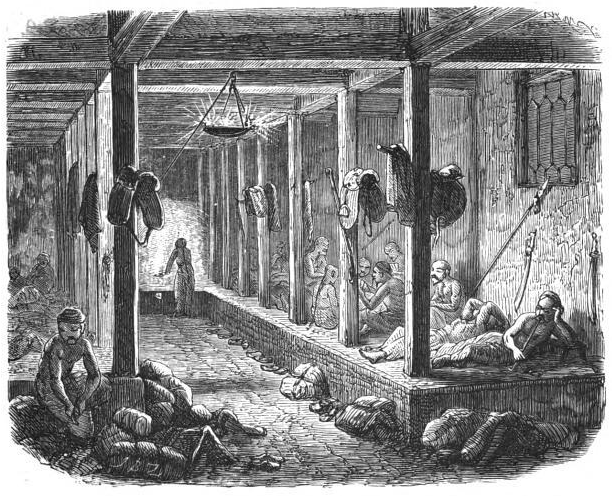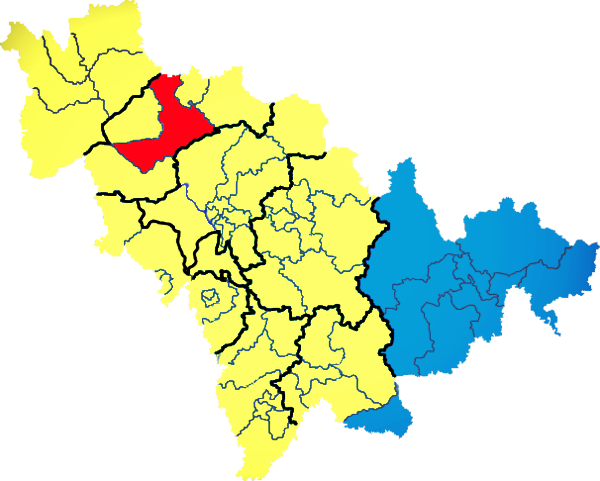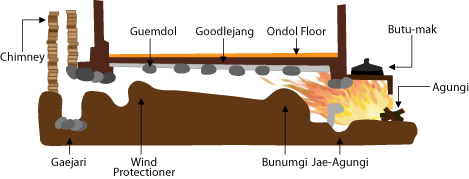|
Kang Bed-stove
The ''kang'' (; Manchu: ''nahan'', ) is a traditional heated platform, 2 metres or more long, used for general living, working, entertaining and sleeping in the northern part of China, where the winter climate is cold. It is made of bricks or other forms of fired clay and more recently of concrete in some locations. The word ''kang'' means "to dry". Its interior cavity, leading to an often-convoluted flue system, channels the hot exhaust from a firewood/coal fireplace, usually the cooking fire from an adjacent room that serves as a kitchen, sometimes from a stove set below floor level. This allows a longer contact time between the exhaust (which still contains much heat from the combustion source) and (indirectly) the inside of the room, hence more heat transfer/recycling back into the room, effectively making it a ducted heating system similar to the Roman hypocaust. A separate stove may be used to control the amount of smoke circulating through the ''kang'', maintaining comfo ... [...More Info...] [...Related Items...] OR: [Wikipedia] [Google] [Baidu] |
Long White Mountain - P235 - Interior Of An Inn
Long may refer to: Measurement * Long, characteristic of something of great duration * Long, characteristic of something of great length * Longitude (abbreviation: long.), a geographic coordinate * Longa (music), note value in early music mensural notation Places Asia * Long District, Laos * Long District, Phrae, Thailand * Longjiang (other) or River Long (lit. "dragon river"), one of several rivers in China * Yangtze River or Changjiang (lit. "Long River"), China Elsewhere * Long, Somme, France People * Long (Chinese surname) * Long (Western surname) Fictional characters * Long (''Bloody Roar''), in the video game series * Long, Aeon of Permanence in Honkai: Star Rail Sports * Long, a fielding term in cricket * Long, in tennis and similar games, beyond the service line during a serve and beyond the baseline during play Other uses * , a U.S. Navy ship name * Long (finance), a position in finance, especially stock markets * Lòng, name for a laneway in Sh ... [...More Info...] [...Related Items...] OR: [Wikipedia] [Google] [Baidu] |
Masonry
Masonry is the craft of building a structure with brick, stone, or similar material, including mortar plastering which are often laid in, bound, and pasted together by mortar (masonry), mortar. The term ''masonry'' can also refer to the building units (stone, brick, etc.) themselves. The common materials of masonry construction are bricks and building stone, rock (geology), rocks such as marble, granite, and limestone, cast stone, concrete masonry unit, concrete blocks, glass brick, glass blocks, and adobe. Masonry is generally a highly durable form of construction. However, the materials used, the quality of the mortar and workmanship, and the pattern in which the units are assembled can substantially affect the durability of the overall masonry construction. A person who constructs masonry is called a mason or bricklayer. These are both classified as construction worker, construction trades. History Masonry is one of the oldest building crafts in the world. The constructio ... [...More Info...] [...Related Items...] OR: [Wikipedia] [Google] [Baidu] |
Tangshan
Tangshan ( zh, c=唐山 , p=Tángshān) is a coastal, industrial prefecture-level city in the northeast of Hebei province. It is located in the eastern part of Hebei Province and the northeastern part of the North China Plain. It is located in the central area of the Bohai Economic Rim, Bohai Rim and serves as the main traffic corridor to the Northeast China, Northeast. The city faces the Bohai Sea in the south, the Yan Mountains in the north, Qinhuangdao across the Luan River to the east, and Tianjin to the west. Much of the city's development is thanks to the industrialization, beginning in 1870, when Kailuan Group established coal mines in the region. It is the birthplace of China's first standard-gauge railway, the first railway plant, the first steam locomotive, and the first cement factory. It was hailed as China's "cradle of industrialization". Even today, Tangshan is a hub of steel, energy, Chemical engineering, chemical, and ceramics production. Ping opera, which origina ... [...More Info...] [...Related Items...] OR: [Wikipedia] [Google] [Baidu] |
Northern Wei Dynasty
Wei (), known in historiography as the Northern Wei ( zh, c=北魏, p=Běi Wèi), Tuoba Wei ( zh, c=拓跋魏, p=Tuòbá Wèi), Yuan Wei ( zh, c=元魏, p=Yuán Wèi) and Later Wei ( zh, t=後魏, p=Hòu Wèi), was an imperial dynasty of China ruled by the Tuoba (Tabgach) clan of the Xianbei. The first of the Northern dynasties, it ruled northern China from 386 to 535 during the period of the Northern and Southern dynasties. Described as "part of an era of political turbulence and intense social and cultural change", the Northern Wei dynasty is particularly noted for unifying northern China in 439, bringing an end to the chaotic Sixteen Kingdoms period, and strengthening imperial control over the rural landscape via reforms in 485. This was also a period of introduced foreign ideas, such as Buddhism, which became firmly established. The Northern Wei was referred to as "Plaited Barbarians" (索虜; ''suǒlǔ'') by writers of the Southern dynasties, who considered themselves th ... [...More Info...] [...Related Items...] OR: [Wikipedia] [Google] [Baidu] |
Commentary On The Water Classic
The ''Commentary on the Water Classic'' (), or ''Commentaries on the Water Classic'', commonly known as ''Shui Jing Zhu'', is a work on the Chinese geography in ancient times, describing the traditional understanding of its waterways and ancient canals, compiled by Li Daoyuan during the Northern Wei dynasty (386–534 AD). The book is divided into sections by river, each described with its source, course, and major tributaries, including cultural and historical notes. The work is much expanded from its source text, the older (and now lost) ''Water Classic'' (''Shuijing'' 水經). The original text described 137 different rivers in China and was traditionally credited to Eastern Han scholar and geographer Sang Qin (桑钦) during the Three Kingdoms period (220–280 AD). Qing dynasty scholars gave it a later date (during the Three Kingdoms period) because of the names of the counties and commanderies. Its authorship was then attributed to Jin dynasty scholar Guo Pu. Li Daoyu ... [...More Info...] [...Related Items...] OR: [Wikipedia] [Google] [Baidu] |
Li Daoyuan
Li Daoyuan (; 466 or 472 in Zhuo County, Hebei – 527) was a Chinese geographer, politician, and writer during the Northern Wei dynasty. He is known as the author of the '' Commentary on the Water Classic'' (''Shuijingzhu''), a monumental work on China's geography in ancient times. Li used his position as an official with business in different places to carry field investigations. He is known to have visited the area belonging to the present-day Henan, Shandong, Shanxi, and Jiangsu provinces.China Culture.org.Li Daoyuan".China Culture.org.". Another source for his knowledge was the study of ancient geographical books he had access to, like the '' Classic of Mountains and Seas'' (''Shanhaijing'') completed by the time of the early Western Han dynasty The Han dynasty was an imperial dynasty of China (202 BC9 AD, 25–220 AD) established by Liu Bang and ruled by the House of Liu. The dynasty was preceded by the short-lived Qin dynasty (221–206 BC ... [...More Info...] [...Related Items...] OR: [Wikipedia] [Google] [Baidu] |
Adobe
Adobe (from arabic: الطوب Attub ; ) is a building material made from earth and organic materials. is Spanish for mudbrick. In some English-speaking regions of Spanish heritage, such as the Southwestern United States, the term is used to refer to any kind of earthen construction, or various architectural styles like Pueblo Revival or Territorial Revival. Most adobe buildings are similar in appearance to cob and rammed earth buildings. Adobe is among the earliest building materials, and is used throughout the world. Adobe architecture has been dated to before 5,100 BP. Description Adobe bricks are rectangular prisms small enough that they can quickly air dry individually without cracking. They can be subsequently assembled, with the application of adobe mud to bond the individual bricks into a structure. There is no standard size, with substantial variations over the years and in different regions. In some areas a popular size measured weighing about ; in other ... [...More Info...] [...Related Items...] OR: [Wikipedia] [Google] [Baidu] |
Jilin Province
) , image_skyline = Changbaishan Tianchi from western rim.jpg , image_alt = , image_caption = View of Heaven Lake , image_map = Jilin in China (+all claims hatched).svg , mapsize = 275px , map_alt = Map showing the location of Jilin Province , map_caption = Map showing the location of Jilin Province , coordinates = , subdivision_type = Country , subdivision_name = China , named_for = from ''girin ula'', a Manchu phrase meaning "along the river" , seat_type = Capital , seat = , seat1_type = , seat1 = , parts_type = Divisions , parts_style = para , p1 = 9 prefectures , p2 = 60 counties , p3 = 1006 townships , government_type = Province , governing_body = Jilin Provincial People's Congress , leader_title = Party Secretary , leader_name = Huang Q ... [...More Info...] [...Related Items...] OR: [Wikipedia] [Google] [Baidu] |
Heilongjiang Province
Heilongjiang is a province in northeast China. It is the northernmost and easternmost province of the country and contains China's northernmost point (in Mohe City along the Amur) and easternmost point (at the confluence of the Amur and Ussuri rivers). The province is bordered by Jilin to the south and Inner Mongolia to the west. It also shares a border with Russia ( Amur Oblast, Jewish Autonomous Oblast, Khabarovsk Krai, Primorsky Krai and Zabaykalsky Krai) to the north and east. The capital and the largest city of the province is Harbin. Among Chinese provincial-level administrative divisions, Heilongjiang is the sixth-largest by total area, the 20th-most populous, and the second-poorest by GDP per capita after only Gansu province. The province takes its name from the Amur river which marks the border between the People's Republic of China and Russia. Heilongjiang has significant agricultural production, and raw materials, such as timber, oil, and coal. Etymology Th ... [...More Info...] [...Related Items...] OR: [Wikipedia] [Google] [Baidu] |
Ondol
(; , ; ) or ''gudeul'' (; ) in Korean traditional architecture is underfloor heating that uses direct heat transfer from wood smoke to heat the underside of a thick masonry floor. In modern usage, it refers to any type of underfloor heating, or to a hotel or a sleeping room in Korean (as opposed to Western) style. The main components of the traditional ondol are an '' agungi'' (; ), a '' firebox'' or '' stove'', accessible from an adjoining room (typically kitchen or master bedroom), a raised masonry floor underlain by horizontal smoke passages, and a vertical, freestanding chimney on the opposite exterior wall providing a draft. The heated floor, supported by stone piers or baffles to distribute the smoke, is covered by stone slabs, clay and an impervious layer such as oiled paper. History Origin Use of the has been found at archaeological sites in present-day North Korea. A Neolithic Age archaeological site, ''circa'' 5000 BC, discovered in Sonbong, Rason, in present-day ... [...More Info...] [...Related Items...] OR: [Wikipedia] [Google] [Baidu] |
Ancient Rome
In modern historiography, ancient Rome is the Roman people, Roman civilisation from the founding of Rome, founding of the Italian city of Rome in the 8th century BC to the Fall of the Western Roman Empire, collapse of the Western Roman Empire in the 5th century AD. It encompasses the Roman Kingdom (753–509 BC), the Roman Republic (50927 BC), and the Roman Empire (27 BC476 AD) until the fall of the western empire. Ancient Rome began as an Italic peoples, Italic settlement, traditionally dated to 753 BC, beside the River Tiber in the Italian peninsula. The settlement grew into the city and polity of Rome, and came to control its neighbours through a combination of treaties and military strength. It eventually controlled the Italian Peninsula, assimilating the Greece, Greek culture of southern Italy (Magna Graecia) and the Etruscans, Etruscan culture, and then became the dominant power in the Mediterranean region and parts of Europe. At its hei ... [...More Info...] [...Related Items...] OR: [Wikipedia] [Google] [Baidu] |
Moisture
Moisture is the presence of a liquid, especially water, often in trace amounts. Moisture is defined as water in the adsorbed or absorbed phase. Small amounts of water may be found, for example, in the air (humidity), in foods, and in some commercial products. Moisture also refers to the amount of water vapor present in the air. The soil also includes moisture. Moisture control in products Control of moisture in products can be a vital part of the process of the product. There is a substantial amount of moisture in what seems to be dry matter. Ranging in products from cornflake cereals to laundry detergent, washing powders, moisture can play an important role in the final quality of the product. There are two main aspects of concern in moisture control in products: allowing too much moisture or too little of it. For example, adding some water to cornflake cereal, which is sold by weight, reduces costs and prevents it from tasting too dry, but adding too much water can affect th ... [...More Info...] [...Related Items...] OR: [Wikipedia] [Google] [Baidu] |







